| Revision as of 10:10, 10 April 2015 editFakirbakir (talk | contribs)Extended confirmed users12,899 edits according to the sources provided by Idsocol← Previous edit | Revision as of 10:14, 10 April 2015 edit undoFakirbakir (talk | contribs)Extended confirmed users12,899 editsmNo edit summaryNext edit → | ||
| Line 6: | Line 6: | ||
| The ], a subgroup of the ],<ref name="Stroschein"/><ref>{{cite book |title= Protestantism and politics in eastern Europe and Russia: the communist and postcommunist eras|last=Ramet |first=Sabrina P. |authorlink= |coauthors= |year=1992 |volume=3|publisher=] |location= |isbn=<!--0-8223-1241-7,--> 9780822312413|page=160 |pages= |url= http://books.google.com/books?id=O4GGgAmzl3gC&pg=PA160&lpg=PA160&dq=%22+subgroup+of+the+Hungarian+people%22&source=bl&ots=YhrN5qBKi3&sig=5-gfSElwcIlLXFyHWxDMmRd1SDI&hl=ro&ei=bkT9S9DMB4issAa3p9SfCA&sa=X&oi=book_result&ct=result&resnum=1&ved=0CBQQ6AEwAA#v=onepage&q=%22%20subgroup%20of%20the%20Hungarian%20people%22&f=false|accessdate=|quote=...the Szekler community, now regarded as a subgroup of the Hungarian people.}}</ref> live in the valleys and hills of the ], corresponding to the present-day ], ], and parts of ] counties in ]. Originally, the name ''Székely Land'' denoted an ] within ]{{Citation needed|date=April 2015}}. It existed as a legal entity from medieval times until the ]{{Citation needed|date=July 2013}}, when the Székely and ] ]s were dissolved and replaced by the ]. | The ], a subgroup of the ],<ref name="Stroschein"/><ref>{{cite book |title= Protestantism and politics in eastern Europe and Russia: the communist and postcommunist eras|last=Ramet |first=Sabrina P. |authorlink= |coauthors= |year=1992 |volume=3|publisher=] |location= |isbn=<!--0-8223-1241-7,--> 9780822312413|page=160 |pages= |url= http://books.google.com/books?id=O4GGgAmzl3gC&pg=PA160&lpg=PA160&dq=%22+subgroup+of+the+Hungarian+people%22&source=bl&ots=YhrN5qBKi3&sig=5-gfSElwcIlLXFyHWxDMmRd1SDI&hl=ro&ei=bkT9S9DMB4issAa3p9SfCA&sa=X&oi=book_result&ct=result&resnum=1&ved=0CBQQ6AEwAA#v=onepage&q=%22%20subgroup%20of%20the%20Hungarian%20people%22&f=false|accessdate=|quote=...the Szekler community, now regarded as a subgroup of the Hungarian people.}}</ref> live in the valleys and hills of the ], corresponding to the present-day ], ], and parts of ] counties in ]. Originally, the name ''Székely Land'' denoted an ] within ]{{Citation needed|date=April 2015}}. It existed as a legal entity from medieval times until the ]{{Citation needed|date=July 2013}}, when the Székely and ] ]s were dissolved and replaced by the ]. | ||
| Along with Transylvania, Székely Land became a part of Romania in 1920, in accordance with the ]. In August 1940, as a consequence of the ], the ], including Székely Land, were ceded to ], under ] auspices. Transylvania became occupied by Soviet and Romanian forces in 1944<ref>{{cite book |title= The Remote Borderland|last=Kurti |first=Laszlo |authorlink= |coauthors= |year=2001 |volume=|publisher=] |location= |isbn=|page=33 |pages= |url= https://books.google.de/books?id=tHJPU14MvfMC&pg=PA30&lpg=PA30&dq=transylvania+union+with+romania+1918&source=bl&ots=0m39CyRZo1&sig=wJErQEG_-2cM7YyF4cVFOl1gBcw&hl=ro&sa=X&ei=IhUlVfP-OImwsQG5tISACA&ved=0CD0Q6AEwBjgK#v=onepage&q=transylvania%20union%20with%20romania%201918&f=false|accessdate=|quote=}}</ref><ref>{{cite book |title= War in the Balkans|last=Hall |first=Richard C. |authorlink= |coauthors= |year=2014 |volume=|publisher=ABC-CLIO, LLC |location= Santa Barbara, California|isbn=|page=249 |pages= |url= https://books.google.de/books?id=wy3TBAAAQBAJ&pg=PA249&lpg=PA249&dq=transylvania+romanian+army+1944&source=bl&ots=qgAgISiHsc&sig=OJrPGuQM21A_FH7o7ON-bYo4nrY&hl=ro&sa=X&ei=HyclVdC-F-bXyQPM8YHQCA&ved=0CGoQ6AEwDA#v=onepage&q=transylvania%20romanian%20army%201944&f=false|accessdate=|quote=}}</ref><ref></ref> and got back to Romania by the ] signed after World War II, in 1947. | Along with Transylvania, Székely Land became a part of Romania in 1920, in accordance with the ]. In August 1940, as a consequence of the ], the ], including Székely Land, were ceded to ], under ] auspices. Transylvania became occupied by Soviet and Romanian forces in 1944,<ref>{{cite book |title= The Remote Borderland|last=Kurti |first=Laszlo |authorlink= |coauthors= |year=2001 |volume=|publisher=] |location= |isbn=|page=33 |pages= |url= https://books.google.de/books?id=tHJPU14MvfMC&pg=PA30&lpg=PA30&dq=transylvania+union+with+romania+1918&source=bl&ots=0m39CyRZo1&sig=wJErQEG_-2cM7YyF4cVFOl1gBcw&hl=ro&sa=X&ei=IhUlVfP-OImwsQG5tISACA&ved=0CD0Q6AEwBjgK#v=onepage&q=transylvania%20union%20with%20romania%201918&f=false|accessdate=|quote=}}</ref><ref>{{cite book |title= War in the Balkans|last=Hall |first=Richard C. |authorlink= |coauthors= |year=2014 |volume=|publisher=ABC-CLIO, LLC |location= Santa Barbara, California|isbn=|page=249 |pages= |url= https://books.google.de/books?id=wy3TBAAAQBAJ&pg=PA249&lpg=PA249&dq=transylvania+romanian+army+1944&source=bl&ots=qgAgISiHsc&sig=OJrPGuQM21A_FH7o7ON-bYo4nrY&hl=ro&sa=X&ei=HyclVdC-F-bXyQPM8YHQCA&ved=0CGoQ6AEwDA#v=onepage&q=transylvania%20romanian%20army%201944&f=false|accessdate=|quote=}}</ref><ref></ref> and got back to Romania by the ] signed after World War II, in 1947. | ||
| Under the name ], with Târgu-Mureş as capital,<ref></ref> parts of Székely Land enjoyed a certain level of autonomy between 8 September 1952 and 16 February 1968. | Under the name ], with Târgu-Mureş as capital,<ref></ref> parts of Székely Land enjoyed a certain level of autonomy between 8 September 1952 and 16 February 1968. | ||
Revision as of 10:14, 10 April 2015


The Székely Land or Szeklerland (pronounced Template:IPA-hu, Template:Lang-hu, Template:Lang-ro (also Secuimea), Template:Lang-de, Template:Lang-la) is a historic and ethnographic area in Romania, inhabited mainly by Hungarians and Romanians. Its cultural centre is the city of Târgu Mureș, the largest settlement in the region.
The Székelys, a subgroup of the Hungarian people, live in the valleys and hills of the Eastern Carpathian Mountains, corresponding to the present-day Harghita, Covasna, and parts of Mureş counties in Romania. Originally, the name Székely Land denoted an autonomous region within Transylvania. It existed as a legal entity from medieval times until the Austro-Hungarian Compromise of 1867, when the Székely and Saxon seats were dissolved and replaced by the county system.
Along with Transylvania, Székely Land became a part of Romania in 1920, in accordance with the Treaty of Trianon. In August 1940, as a consequence of the Second Vienna Award, the northern territories of Transylvania, including Székely Land, were ceded to Hungary, under Third Reich auspices. Transylvania became occupied by Soviet and Romanian forces in 1944, and got back to Romania by the Paris peace treaties signed after World War II, in 1947.
Under the name Magyar Autonomous Region, with Târgu-Mureş as capital, parts of Székely Land enjoyed a certain level of autonomy between 8 September 1952 and 16 February 1968. There are territorial autonomy initiatives with the aim to obtain self-governance for this region within Romania.
History
See also: History of the Székely people and Hungarians in Romania

Ancient Hungarian legends suggest a connection between the Székely people and Attila's Huns, but the origins of the Székely people are widely debated. The Székely seats were the traditional self-governing territorial units of the Transylvanian Székelys during medieval times. (Saxons were also organised in seats.) The Seats were not part of the traditional Hungarian county system, and their inhabitants enjoyed a higher level of freedom (especially until the 18th century) than those living in the counties.
From the 12th and 13th centuries until 1876, the Székely Land enjoyed a considerable but varying amount of autonomy, first as a part of the Kingdom of Hungary, then inside the Principality of Transylvania, and finally as a part of the Habsburg Empire. The autonomy was largely due to the military service the Székely provided until the beginning of the 18th century. The medieval Székely Land was an alliance of the seven autonomous Székely seats of Udvarhely, Csík, Maros, Sepsi, Kézdi, Orbai and Aranyos. The number of seats later decreased to five, when Sepsi, Kézdi and Orbai seats were united into one territorial unit called Háromszék (literally Three seats).
The main seat was Udvarhely seat, which was also called the Principal seat (Template:Lang-la) At Szekelyudvarhely (Odorheiu Secuiesc) were held many national assemblies of the Székelys A known exception is the 1554 assembly, which took place at Marosvásáhrely (Târgu Mureș)
As a result of the Austro-Hungarian Compromise of 1867, Transylvania became again part of the Kingdom of Hungary within Austria-Hungary and ceased to exist as a separate legal or administrative entity. In 1876, a general administrative reform abolished all the autonomous areas in the Kingdom of Hungary and created a unified system of counties. As a result, the autonomy of the Székely Land came to an end as well. Four counties were created in its place: Udvarhely, Háromszék, Csík, and Maros-Torda. (Only half of the territory of Maros-Torda originally belonged to Székely Land.) The isolated Aranyosszék became a district of Torda-Aranyos county.
In December 1918, in the wake of the First World War, Romanian delegates from throughout Transylvania voted to join the Kingdom of Romania; this move was internationally recognized in the 1920 Treaty of Trianon. The Romanian language officially replaced Hungarian in the Székely Land, but Székely county boundaries were preserved, and Székely districts were able to elect their own officials at local level and to preserve Hungarian-language education.
In 1940, Romania was forced to cede Northern Transylvania to Hungary in the Second Vienna Award; this territory included most of the historical Székely areas. Hungarian authorities subsequently restored the pre-Trianon structure with slight modifications.
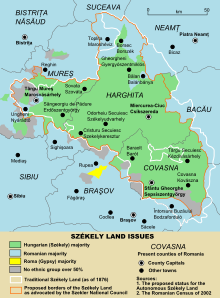
Following the territory's return to Romania after World War II, a Magyar Autonomous Region was created in 1952, which encompassed most of the land inhabited by the Székely. This region lasted until 1968 when the administrative reform divided Romania into the current counties. Roughly speaking, present-day Harghita County encompasses the former Udvarhely and Csík, the latter including Gyergyószék; Covasna County covers more or less the territory of the former Háromszék; and what was once Maros-Torda is mostly part of present-day Mureş County. The former Aranyosszék is today divided between Cluj and Alba counties.
After the fall of communism, many hoped that the former Magyar Autonomous Region, abolished by Nicolae Ceauşescu's regime, would soon be restored again. This has not happened; however, there are Székely autonomy initiatives and further efforts from Székely organisations to reach a higher level of self-governance for the Székely Land within Romania.
On 2 February 2009, Romanian President Traian Băsescu met the Hungarian President László Sólyom in Budapest and discussed the issues of minority rights and regional autonomy. Băsescu affirmed "The Hungarian minority will never be given territorial autonomy."
In 2014, the UDMR and the Hungarian Civic Party had a joint autonomy proposal for Szeklerland but the Szekler National Council also possessed its own suggestion.
-
 Traditional Székely Land (19th century)
Traditional Székely Land (19th century)
-
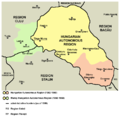 Hungarian autonomous provinces under the Communist era
Hungarian autonomous provinces under the Communist era
-
 Present-day counties of Harghita, Covasna, and Mureș within Romania
Present-day counties of Harghita, Covasna, and Mureș within Romania
Constitutional issues
Article 1 of the Romanian Constitution defines the country as a "sovereign, independent, unitary and indivisible national state." It has often been argued that, as a result of this provision, any ethnic-based territorial autonomy, including that of the Székely Land, would be unconstitutional.
Population
Main article: SzékelysIn 2002 the estimated ethnic composition of Székely Land consisted of Hungarians (61%), Romanians (33%), Germans (3%) and Roma (3%). The area forms a Hungarian ethnic enclave within present-day Romania.
The population of the Székely Land (according to the 2002 census) is 809,000, 612,043 of them Hungarians, accounting for 75.65% of the total. The Hungarians represent 59% of the populations of Harghita, Covasna and Mureș counties. The percentage of Hungarians is higher in Harghita and Covasna (84.8% and 73.58% respectively), and lower in Mureș County, not all of which falls inside the traditional region (37.82%).
According to the 2011 official census, 609,033 Hungarians (56,8%) live in the counties of Covasna, Harghita and Mureș (out of a total population of 1,071,890 inhabitants). In Mureș county the Romanians are the most numerous (52.6%), while in the counties of Covasna and Harghita, the Hungarians make up the majority (71,6% and 82,9%). The 2011 census compared to the data of the previous census (2002) also shows that the Romanian ethnic ratio in Szeklerland has been decreasing (due to emigration).
Târgu Mureș is the home for the largest community of Hungarians in Romania (57,532 in 2011), but the town itself has Romanian majority (66,943 out of 127,849 inhabitants).
Important centers of the Székely Land are Târgu-Mureş (Marosvásárhely), Miercurea Ciuc (Csíkszereda), Sfântu Gheorghe (Sepsiszentgyörgy), and Odorheiu Secuiesc (Székelyudvarhely).
-
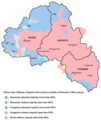 Ethnic map of Harghita, Covasna, and Mureș based on the 1992 data, showing areas with Hungarian majority
Ethnic map of Harghita, Covasna, and Mureș based on the 1992 data, showing areas with Hungarian majority
-
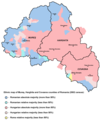 Ethnic map of Harghita, Covasna, and Mureș based on the 2002 data, showing areas with Hungarian majority
Ethnic map of Harghita, Covasna, and Mureș based on the 2002 data, showing areas with Hungarian majority
-
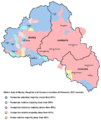 Ethnic map of Harghita, Covasna, and Mureș based on the 2011 data, showing areas with Hungarian majority
Ethnic map of Harghita, Covasna, and Mureș based on the 2011 data, showing areas with Hungarian majority
Territory
See also: List of Székely settlementsThe exact territory of present-day Szeklerland is disputed. The boundaries of the historical Székely seats and the present-day administrative divisions of Romania are dissimilar. According to Minahan its territory is an estimated 16,943 square kilometres (6,542 sq mi). The autonomy proposal of the Szekler National Council consists of about 13,000 km. This size is close to the extent of the historical Székely Land. However, it does not contain the region of Aranyos Seat. The UDMR's autonomy project covers a slightly bigger territory. It includes the whole territories of Mureș, Harghita, and Covasna counties.
Tourist attractions

- Székely fortified churches - more than 20 Székely villages count fortified churches
- Baroque church at Şumuleu Ciuc (Csíksomlyó), a major Roman Catholic pilgrimage site
- Rural tourism
- Hiking in the Carpathians
- Mofette, spas
- Mineral springs, thermal baths
- Salt mines (treatment against allergy and asthma)
- Traditional Székely handicrafts (pottery, wood carving)
- Mikó Castle
- Kálnoky Castle
- Teleki Library
- Székely National Museum (Muzeul Național Secuiesc/Székely Nemzeti Múzeum), Sfântu Gheorghe/Sepsiszentgyörgy
- Szekler Museum of Ciuc (Muzeul Secuiesc al Ciucului/Csíki Székely Múzeum), Miercurea-Ciuc/Csíkszereda
Image gallery
-
 The fortified church of Dârjiu / Székelyderzs is on UNESCO's World Heritage List
The fortified church of Dârjiu / Székelyderzs is on UNESCO's World Heritage List
-
 Szent István chapel of Sânzieni, originally built in the 12th century
Szent István chapel of Sânzieni, originally built in the 12th century
-
 Lázár Castle
Lázár Castle
-
 Mikó Castle
Mikó Castle
-
 Pottery shop in Corund, Harghita
Pottery shop in Corund, Harghita
-
 Mountains surrounding the Red Lake
Mountains surrounding the Red Lake
- Memorial for Áron Tamási Memorial for Áron Tamási
-
 Târgu Secuiesc, town in the Székely Land
Târgu Secuiesc, town in the Székely Land
-
Székely gate in Siculeni
-
 Decorated wooden weaving tool from Székely Land
Decorated wooden weaving tool from Székely Land
-
 Kürtőskalács, a local treat
Kürtőskalács, a local treat
-
 Salt-water lake in Sovata
Salt-water lake in Sovata
-
 Áron Gábor's sculpture in Bretcu
Áron Gábor's sculpture in Bretcu
-
 Alexander Csoma de Kőrös's statue in Covasna
Alexander Csoma de Kőrös's statue in Covasna
Notes
- ^ Béla Tomka, A Social History of Twentieth-Century Europe, Routledge, 2013, p. 411
- George Schöpflin, Nations, Identity, Power: The New Politics of Europe, C. Hurst & Co. Publishers, 2000, p. 404
- ^ James Minahan, Encyclopedia of the stateless nations. 4. S - Z, Greenwood Publishing Group, 2002, p. 1810
- ^ Sherrill Stroschein, Ethnic Struggle, Coexistence, and Democratization in Eastern Europe, Cambridge University Press, 2012, p. 210 Cited: "Székely, a Hungarian sub-group that is concentrated in the mountainous Hungarian enclave"
- Ramet, Sabrina P. (1992). Protestantism and politics in eastern Europe and Russia: the communist and postcommunist eras. Vol. 3. Duke University Press. p. 160. ISBN 9780822312413.
...the Szekler community, now regarded as a subgroup of the Hungarian people.
{{cite book}}: Cite has empty unknown parameter:|coauthors=(help) - Kurti, Laszlo (2001). The Remote Borderland. State University of New York Press. p. 33.
{{cite book}}: Cite has empty unknown parameter:|coauthors=(help) - Hall, Richard C. (2014). War in the Balkans. Santa Barbara, California: ABC-CLIO, LLC. p. 249.
{{cite book}}: Cite has empty unknown parameter:|coauthors=(help) - the Armistice Agreement with Romania
- http://mek.oszk.hu/03100/03187/03187.pdf
- Kulish, Nicholas (2008-04-07). "Kosovo's Actions Hearten a Hungarian Enclave". The New York Times. Retrieved 2008-04-08.
{{cite news}}: Italic or bold markup not allowed in:|publisher=(help) - Manifesto of the Szekely Assembly
- http://www.budapesttimes.hu/2013/03/18/world-protests-back-szekely-autonomy/
- http://www.sznt.ro/en/?option=com_content&view=article&id=210
- Tab8. Populația stabilă după etnie – județe, municipii, orașe, comune. "Rezultatele recensământului din 2011".
{{cite web}}: Check|url=value (help) - Horváth István, Tonk Márton, Minority politics within the Europe of regions, Editura ISPMN, 2014, p. 205
- COMUNICAT DE PRESĂ 24 august 2012 privind rezultatele preliminare ale Recensământului Populaţiei şi al Locuinţelor – 2011 în judeţul Mureş (PDF) (Report) (in Romanian). National Institute of Statistics (Romania). 2012-08-24. p. 14. Retrieved 2015-04-04.
See also
- Hungarians in Romania
- Hungarian Autonomous Province
- Ethnic clashes of Târgu Mureş
- Szekler National Council
- Székely Himnusz
External links